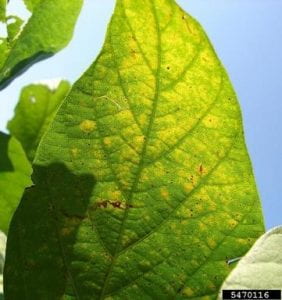Nathan Kleczewski, Extension Specialist – Plant Pathology; nkleczew@udel.edu
Over the last week Mississippi has really lit up, and there have been an increased number of SBR reports in South Carolina. One southern county in North Carolina reported SBR. The weather over the next 4-5 days does not suggest any great chance for northern spread. There are no reports of SBR in Kentucky, Maryland, or Virginia at this time. So far this year SBR has been detected in 154 counties in eight states including Alabama, Mississippi, Florida, Georgia, Louisiana, South Carolina, Arkansas, and North Carolina (Figure 1). The current SBR risk in Delaware is still low. Remember, if spores of SBR would make it into Delaware it will likely take 2-3 weeks before inoculum will build up to detectable levels, and then another 3 weeks under optimal environmental conditions before inoculum levels would likely reach levels where we might expect reductions in yield. The likelihood of all of these factors occurring are low, but we still need to keep SBR in the back of our minds as we scout double crop beans through R6. For this reason I am including some information on SBR scouting in this update.
 Figure 1. Soybean rust confirmations as of September 9th, 2013. Image obtained from http://sbr.ipmpipe.org/cgi-bin/sbr/public.cgi
Figure 1. Soybean rust confirmations as of September 9th, 2013. Image obtained from http://sbr.ipmpipe.org/cgi-bin/sbr/public.cgi
How to Scout for SBR
From R1 to R6 scout fields every other week. Depending on the size of the field, five to 10 sections of 10-20 ft row length should be scouted. Ensure that sites are chosen throughout the field and are not focused on particular areas of the field (i.e. edges, areas near roads or entrance paths). One way to ensure that the field is properly covered is to scout in a zig-zag pattern. Pay attention to areas where humidity levels may be greater, such as those near tree lines, shaded locations, and bodies of water. Increase scouting frequency if forecasts indicate that SBR movement into the area is likely.
Focus on lower and middle portions of the canopy for symptoms of early stages of the disease. Using a hand lens, look for chlorosis and brown red-brown, or black pinpoint spots on the upper leaf surface. These are the early symptoms of the disease and they can be easily confused with other soybean diseases such as brown spot, frogeye leaf spot, bacterial pustule, bacterial blight, and downy mildew. Older infections may have raised, dusty, brown to red brown pustules that contain spores of the fungus. Sometimes it is easier to see disease symptoms if the leaf is held up to the sky (Figure 2) A helpful key to differentiating SBR from these other diseases can be found here: http://ohioline.osu.edu/sbr-fact/pdf/0001-English.pdf. Hard copies of this document are also available at the UD Plant Diagnostic lab and our Kent and Sussex county locations.
SBR cannot be diagnosed in the field and can only be diagnosed in the laboratory. If you find suspect plants, collect 10-20 leaves and place them in a sealed plastic bag. Place a moist, but not soaking wet, paper towel in the bag. That same day samples should be sent to the UD Plant Diagnostic Clinic or your local UD Cooperative Extension office. Samples can be kept in the refrigerator overnight if they cannot be delivered on the same day.
SBR updates can be found on http://sbr.ipmpipe.org/cgi-bin/sbr/public.cgi.
 Figure 2. Early symptoms of soybean rust may be easier to visualize if the leaf is backlit by sunlight. Image by Daren Mueller and obtained from www.ipmimages.org.
Figure 2. Early symptoms of soybean rust may be easier to visualize if the leaf is backlit by sunlight. Image by Daren Mueller and obtained from www.ipmimages.org.
A new post has been added to the Field Crops Disease Management Blog: Identifying Stalk Rots in Corn
